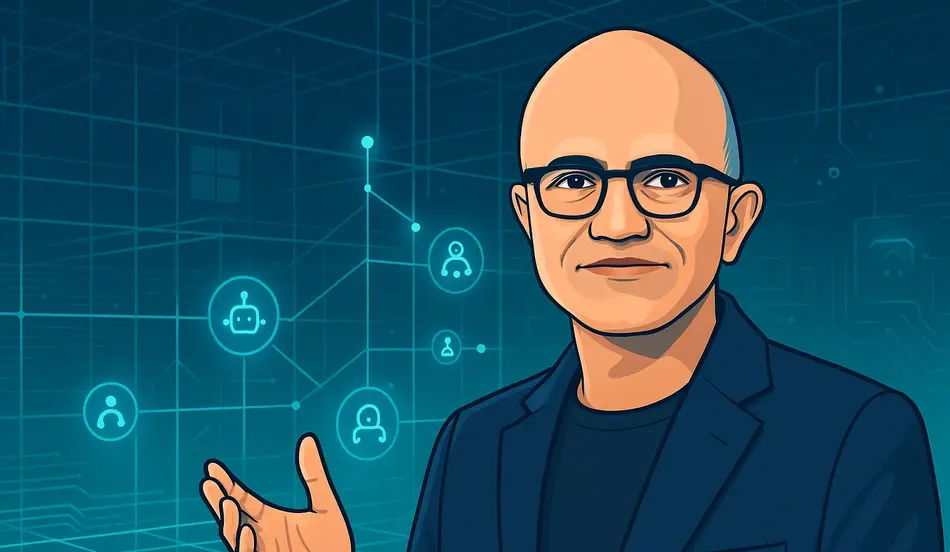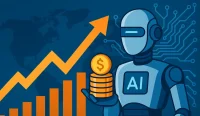AI Agent Era is no longer just a buzzword it represents a new layer of infrastructure shaping how people live and work. Artificial intelligence is moving beyond single apps and coding tools into systems that integrate directly into daily workflows. At Microsoft’s Build developer conference, CEO Satya Nadella described his vision for the “agentic web”: a future where AI agents collaborate with humans across industries, from software development to healthcare to education.
In a wide-ranging conversation, Nadella explained how the role of knowledge workers will evolve, why human oversight will remain essential, and how companies can adapt to an AI-driven economy. His message was clear: this isn’t about replacing humans it’s about restructuring work so that humans and AI collaborate at scale.
Table of Contents
From Apps to Platforms: The Rise of the Agentic Web
According to Nadella, the world is now two to three years into an AI platform shift—the kind of change that happens once every few decades. In the early days of computing, people talked about specific apps like email or spreadsheets. Later, Microsoft bundled them together into Outlook and Teams, redefining productivity.
AI, he argues, is now at the same inflection point. Instead of isolated use cases, the focus is moving to generalized AI platforms where data, models, and orchestrators work together seamlessly.
“What excites me,” Nadella said, “is building a stack where every layer is open, composable, and standardized. That’s what allows us to create this new scaffolding for the AI age.”
This scaffolding includes:
- Microsoft 365 Copilot, a user-facing AI assistant inside Office apps.
- GitHub Copilot, reshaping software development.
- Agent orchestration frameworks like MCP and NL Web.
Together, these pieces enable what Nadella calls “a UI for AI”—interfaces where chat, search, and agents are unified in one place.
Agents in the Real World: From Hospitals to Classrooms
While much of the AI hype has been theoretical, Nadella points to practical examples already making a difference.
One striking case: Stanford Medicine’s use of AI for tumor board meetings. Traditionally, these high-stakes discussions require doctors to gather reports from pathology, labs, and research databases. With AI orchestration, the system pulls relevant data automatically, organizes it, and presents it in Microsoft Teams.
The result is not just efficiency, but better patient outcomes. Doctors can spend more time on decision-making and less time chasing paperwork.
The same principle applies to education. Imagine a teaching doctor leaving a tumor board meeting and instantly turning the insights into a PowerPoint deck for students—generated automatically by AI.
This is the vision Nadella describes: not AI replacing professionals, but augmenting them with orchestration tools that handle repetitive tasks.
Hire Professionals Augmented by AI
Post your job on WhatJobs and reach clinicians, educators, and analysts who use AI orchestration tools to deliver better outcomes—faster.
Post a Job Now →Knowledge Workers as “Agent Managers”
One of the biggest fears around AI is job displacement. Nadella acknowledges this risk but frames it differently: instead of being replaced, knowledge workers will increasingly act as “agent managers.”
He draws a historical parallel. In the 1980s, offices employed typist pools. By the 2000s, everyone became a typist thanks to computers. The work didn’t disappear; it evolved.
Today, he argues, AI is inverting workflows in a similar way. Instead of relying on teams to prepare long reports, leaders can now prompt an AI agent to gather data from emails, CRMs, and supply chains, and receive a comprehensive briefing in minutes.
“I feel more employable today,” Nadella said. “I can get to information faster, collaborate better, and actually do more knowledge work than ever before.”
The key, he emphasizes, is diffusion of tools. Just as PCs and Excel spread through companies, AI copilots must become standard issue across roles—from marketers to engineers to customer success.
Developers and the 95% AI Code Future
Perhaps no group is experiencing this shift more directly than developers. Microsoft has already reported that 30% of new code is AI-generated. But what happens when that number climbs to 90–95%?
Nadella sees this not as a threat, but as a solution to a global shortage of software capacity. “The reality is, we have more demand for software than supply,” he explained.
With AI copilots, developers can:
- Autocomplete complex code with better accuracy than traditional tools.
- Explain code visually (e.g., turning code into flowcharts).
- Assign agents entire multi-file edits instead of line-by-line changes.
Still, Nadella insists, humans remain in the loop. AI-generated code requires review, debugging, and integration into real-world systems. The future isn’t autonomous programming—it’s collaborative programming.
Proprietary Advantage: Fine-Tuning AI with Company Data
Another major announcement at Build was Copilot fine-tuning, which allows enterprises to customize AI copilots using their proprietary data.
Nadella believes this is where sustainable competitive advantage lies. Generic AI models are becoming commodities, but when a company trains copilots on its own data and workflows, it creates a loop of reinforcement that drives business value.
He describes it as a “virtuous cycle”:
- Use internal data to fine-tune AI.
- Deploy copilots into workflows.
- Collect feedback and reinforcement from customers.
- Use that signal to further improve the model.
This, he argues, will become the new theory of the firm—how companies differentiate themselves in the AI era.
Adapting to the Agent Era: Lessons from Microsoft
Nadella has led Microsoft through multiple transformations, from the decline of Windows dominance to the rise of cloud and now AI. His advice to companies is simple but demanding:
- Reinvent constantly – Be willing to change what you work on, how you work, and how you go to market.
- Focus on culture and capability building – Companies must create a culture where teams can experiment, fail, and adapt quickly.
- Do the hard yards yourself – Case studies aren’t enough. “You don’t get fit by watching others go to the gym,” Nadella quipped.
Whether a business is growing or in decline, AI offers both tailwinds and opportunities for reinvention.
Upskilling: Personalized Education Through Tools
A major challenge for enterprises is upskilling employees in a personalized way. A marketer doesn’t need the same training as a developer.
Instead of top-down training programs, Nadella advocates for tool diffusion. Just as Excel became the world’s most widespread programming tool by being embedded in workflows, AI copilots must integrate naturally into daily work.
He gives the example of a Microsoft engineer who built a multi-agent DevOps system to manage fiber network outages. She wasn’t trained formally in AI but used low-code tools to automate her workflow.
This kind of bottom-up empowerment, Nadella argues, is how real reskilling happens.
Turn Your Tools into Career Growth
Search WhatJobs for roles that reward bottom-up upskilling—apply your AI copilots, Excel, and low-code skills to make an immediate impact.
Search Jobs Now →The Future of Proactive Agents
Looking ahead, Nadella sees proactive AI agents as the next step. Instead of waiting for commands, these systems will anticipate user intent and act accordingly—but with transparency and control.
For example, a coding agent can autonomously fix bugs, but with session logs that allow developers to review each step. Similarly, personal AI assistants might summarize emails offline, but only when the user sets the intent.
The balance, Nadella stresses, is between frictionless assistance and user agency.
Beyond AGI: Measuring Impact by Economic Growth
Finally, Nadella addressed a viral remark he made: that AGI benchmarks are “nonsensical.” His point is not to dismiss AI research but to shift focus to real-world impact.
Instead of chasing artificial benchmarks, he believes AI should be judged by its contribution to global productivity and economic growth.
Healthcare is one area where he sees massive potential. With nearly 20% of U.S. GDP spent on healthcare, much of it tied up in inefficiency, AI-driven workflow improvements could both cut costs and improve care.
The same goes for education, where early studies (such as the World Bank’s work in Nigeria) show that AI copilots measurably improve learning outcomes.
“We celebrate tech companies far too much versus the impact of technology,” Nadella said. “The day we celebrate industries across the globe for using technology to do something magical—that’s the day I’m waiting for.”
FAQs: Satya Nadella’s Vision for the AI Agent Era
1. What does Satya Nadella mean by the “agentic web”?
It refers to a new AI-driven layer of the internet where agents—software systems powered by AI—collaborate with humans across workflows. Instead of isolated apps, AI becomes an orchestrator that integrates data, tools, and tasks seamlessly.
2. Will AI replace developers when 90% of code is AI-generated?
No. Nadella believes humans will remain essential for oversight, debugging, and integration. AI will handle repetitive coding tasks, freeing developers to focus on higher-level design and problem-solving.
3. How should companies adapt to the rise of AI agents?
Nadella recommends building a culture of reinvention, empowering employees with tools, and fine-tuning AI with proprietary data to gain a sustainable edge.
4. What industries will benefit most from AI agents?
Healthcare and education are top priorities. In healthcare, AI can reduce inefficiencies and improve outcomes. In education, AI copilots are already showing measurable improvements in student learning.




